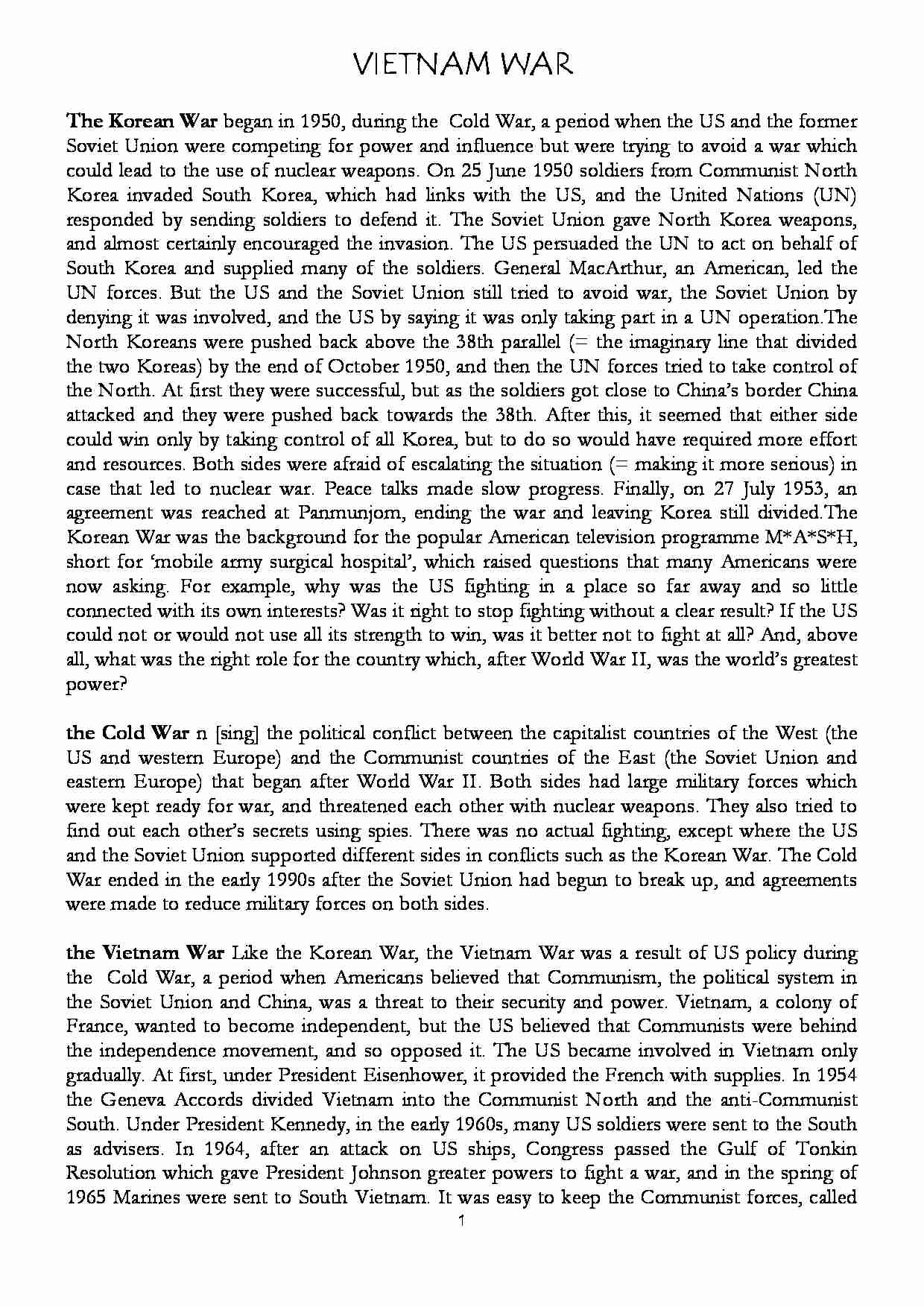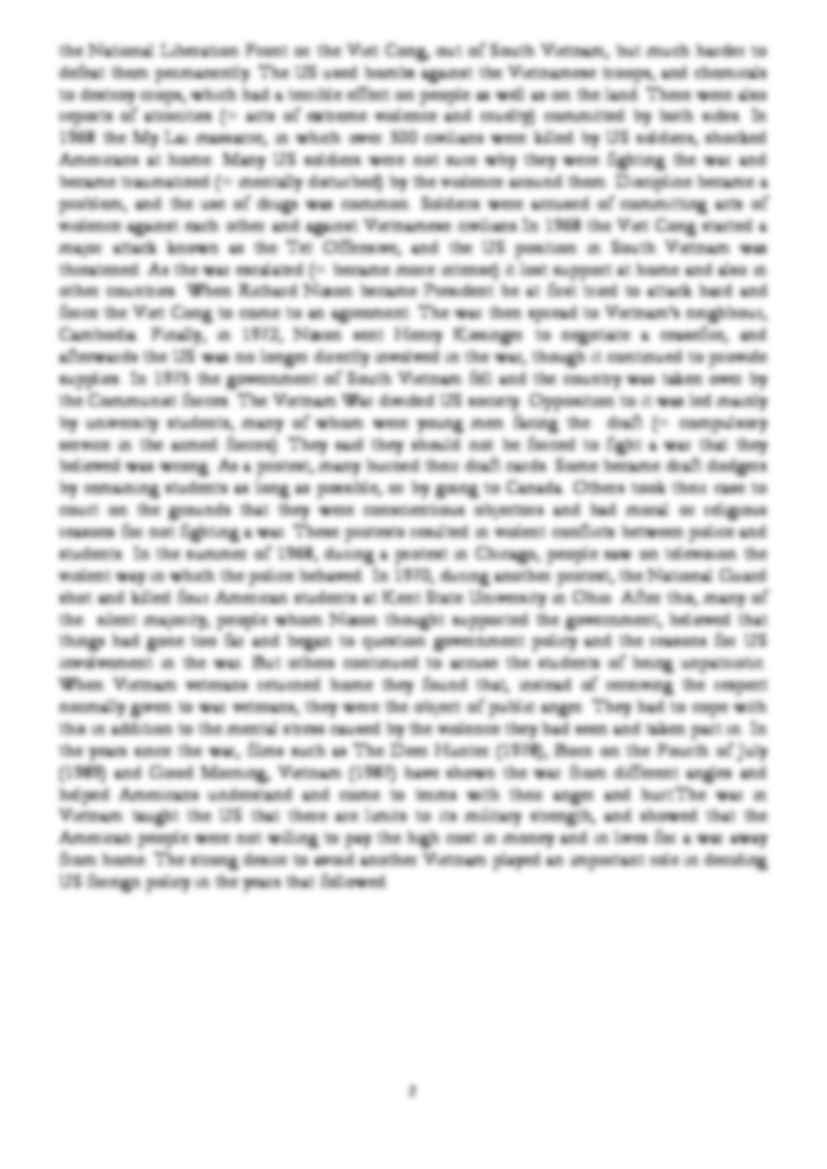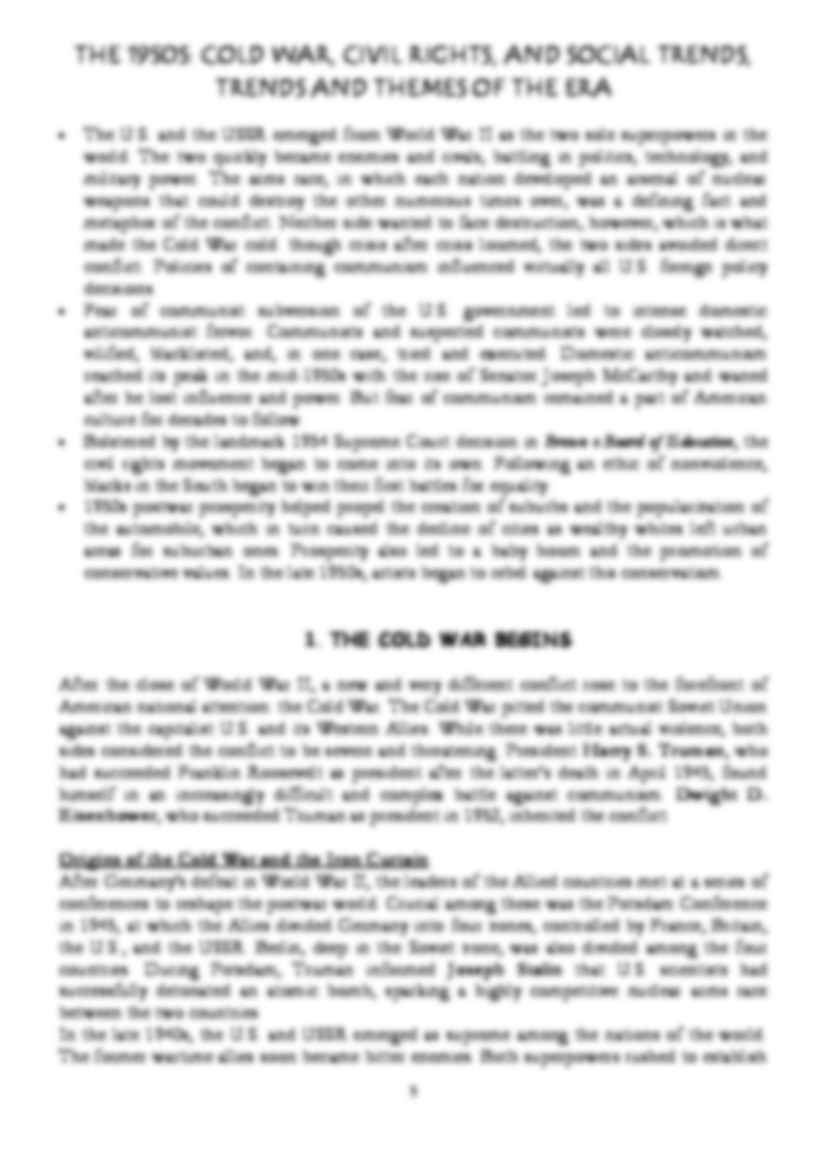


Fragment notatki:
VIETNAM WAR
The Korean War began in 1950, during the Cold War, a period when the US and the former Soviet Union were competing for power and influence but were trying to avoid a war which could lead to the use of nuclear weapons. On 25 June 1950 soldiers from Communist North Korea invaded South Korea, which had links with the US, and the United Nations (UN) responded by sending soldiers to defend it. The Soviet Union gave North Korea weapons, and almost certainly encouraged the invasion. The US persuaded the UN to act on behalf of South Korea and supplied many of the soldiers. General MacArthur, an American, led the UN forces. But the US and the Soviet Union still tried to avoid war, the Soviet Union by denying it was involved, and the US by saying it was only taking part in a UN operation.The North Koreans were pushed back above the 38th parallel (= the imaginary line that divided the two Koreas) by the end of October 1950, and then the UN forces tried to take control of the North. At first they were successful, but as the soldiers got close to China's border China attacked and they were pushed back towards the 38th. After this, it seemed that either side could win only by taking control of all Korea, but to do so would have required more effort and resources. Both sides were afraid of escalating the situation (= making it more serious) in case that led to nuclear war. Peace talks made slow progress. Finally, on 27 July 1953, an agreement was reached at Panmunjom, ending the war and leaving Korea still divided.The Korean War was the background for the popular American television programme M*A*S*H, short for `mobile army surgical hospital', which raised questions that many Americans were now asking. For example, why was the US fighting in a place so far away and so little connected with its own interests? Was it right to stop fighting without a clear result? If the US could not or would not use all its strength to win, was it better not to fight at all? And, above all, what was the right role for the country which, after World War II, was the world's greatest power?
the Cold War n [sing] the political conflict between the capitalist countries of the West (the US and western Europe) and the Communist countries of the East (the Soviet Union and eastern Europe) that began after World War II. Both sides had large military forces which were kept ready for war, and threatened each other with nuclear weapons. They also tried to find out each other's secrets using spies. There was no actual fighting, except where the US and the Soviet Union supported different sides in conflicts such as the Korean War. The Cold War ended in the early 1990s after the Soviet Union had begun to break up, and agreements were made to reduce military forces on both sides.
the Vietnam War Like the Korean War, the Vietnam War was a result of US policy during the Cold War, a period when Americans believed that Communism, the political system in the Soviet Union and China, was a threat to their security and power. Vietnam, a colony of France, wanted to become independent, but the US believed that Communists were behind the independence movement, and so opposed it. The US became involved in Vietnam only gradually. At first, under President Eisenhower, it provided the French with supplies. In 1954 the Geneva Accords divided Vietnam into the Communist North and the anti-Communist South. Under President Kennedy, in the early 1960s, many US soldiers were sent to the South as advisers. In 1964, after an attack on US ships, Congress passed the Gulf of Tonkin Resolution which gave President Johnson greater powers to fight a war, and in the spring of 1965 Marines were sent to South Vietnam. It was easy to keep the Communist forces, called the National Liberation Front or the Viet Cong, out of South Vietnam, but much harder to defeat them permanently. The US used bombs against the Vietnamese troops, and chemicals to destroy crops, which had a terrible effect on people as well as on the land. There were also reports of atrocities (= acts of extreme violence and cruelty) committed by both sides. In 1968 the My Lai massacre, in which over 300 civilians were killed by US soldiers, shocked Americans at home. Many US soldiers were not sure why they were fighting the war and became traumatized (= mentally disturbed) by the violence around them. Discipline became a problem, and the use of drugs was common. Soldiers were accused of committing acts of violence against each other and against Vietnamese civilians.In 1968 the Viet Cong started a major attack known as the Tet Offensive, and the US position in South Vietnam was threatened. As the war escalated (= became more intense) it lost support at home and also in other countries. When Richard Nixon became President he at first tried to attack hard and force the Viet Cong to come to an agreement. The war then spread to Vietnam's neighbour, Cambodia. Finally, in 1972, Nixon sent Henry Kissinger to negotiate a ceasefire, and afterwards the US was no longer directly involved in the war, though it continued to provide supplies. In 1975 the government of South Vietnam fell and the country was taken over by the Communist forces. The Vietnam War divided US society. Opposition to it was led mainly by university students, many of whom were young men facing the draft (= compulsory service in the armed forces). They said they should not be forced to fight a war that they believed was wrong. As a protest, many burned their draft cards. Some became draft dodgers by remaining students as long as possible, or by going to Canada. Others took their case to court on the grounds that they were conscientious objectors and had moral or religious reasons for not fighting a war. These protests resulted in violent conflicts between police and students. In the summer of 1968, during a protest in Chicago, people saw on television the violent way in which the police behaved. In 1970, during another protest, the National Guard shot and killed four American students at Kent State University in Ohio. After this, many of the silent majority, people whom Nixon thought supported the government, believed that things had gone too far and began to question government policy and the reasons for US involvement in the war. But others continued to accuse the students of being unpatriotic. When Vietnam veterans returned home they found that, instead of receiving the respect normally given to war veterans, they were the object of public anger. They had to cope with this in addition to the mental stress caused by the violence they had seen and taken part in. In the years since the war, films such as The Deer Hunter (1978), Born on the Fourth of July (1989) and Good Morning, Vietnam (1987) have shown the war from different angles and helped Americans understand and come to terms with their anger and hurt.The war in Vietnam taught the US that there are limits to its military strength, and showed that the American people were not willing to pay the high cost in money and in lives for a war away from home. The strong desire to avoid another Vietnam played an important role in deciding US foreign policy in the years that followed.
(…)
… was arrested for refusing to give her bus seat to a white man. Led by a minister, Martin Luther King Jr., Montgomery blacks organized a boycott of the bus system. Despite violent attacks on black leaders, the boycott continued, reducing bus revenue by over 60 percent. In 1956, the Supreme Court upheld a lower court's decision outlawing segregation on buses. The success of the Montgomery bus boycott inspired civil rights leaders to adopt Martin Luther King Jr.'s philosophy of nonviolent civil disobedience. To direct his followers in a campaign against segregation and discrimination, King and other black ministers established the Southern Christian Leadership Conference (SCLC) in 1957. The SCLC soon found an ally in the Student Nonviolent Coordinating Committee (SNCC), which formed after a number of sit-ins at businesses that discriminated against blacks.
The civil rights movement gained strength by employing the doctrine of nonviolent civil disobedience during the 1950s. Led by Martin Luther King Jr. and the Southern Christian Leadership Conference, southern blacks staged direct acts of defiance against segregation.
Social Trends of the 1950s
The decade following World War II was characterized…
… deteriorated. American Culture: Television, Rock-and-Roll, and the Beats
Television grew rapidly as the entertainment medium of choice. By the 1960s, more than 90 percent of American households owned at least one television. Television brought a message of conformity and consumerism to the American people. Programs fed Americans a steady diet of cookie-cutter idealizations of American life filled with racial…
… period, some elements of culture rebelled. One source of rebellion was rock-and-roll, which rose to prominence in the 1950s. No one epitomized rock-and-roll during the 1950s more than Elvis Presley, who produced 14 consecutive records between 1956 and 1958 that each sold over a million copies. Elvis's sexual innuendo and hip gyrations shocked many middle-class parents but captured the attention of their…
… “the best and the brightest” by historian David Halberstam. Robert McNamara, the president of Ford Motor Company, served as secretary of defense. McGeorge Bundy, a dean of Harvard University, was special assistant for national security affairs, and the president's brother Robert Kennedy filled the post of attorney general. JFK carefully crafted his image as a young, intelligent, and vibrant leader…
... zobacz całą notatkę

Komentarze użytkowników (0)